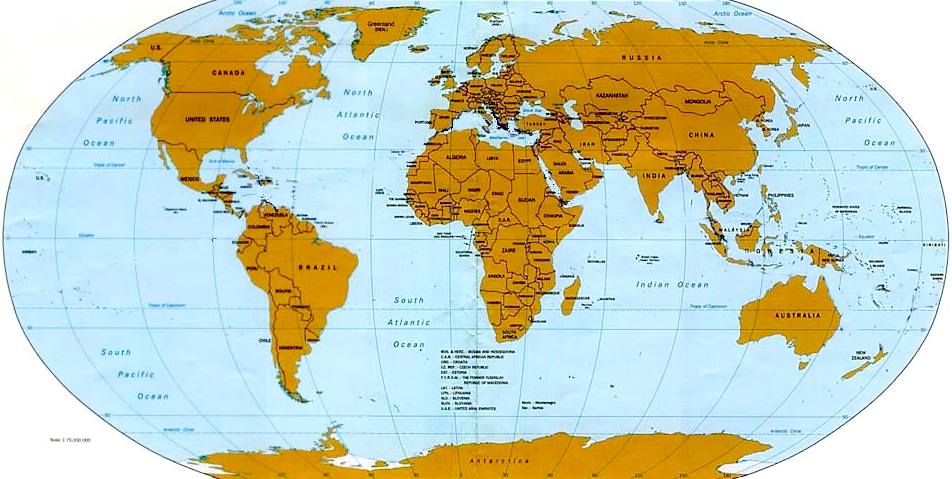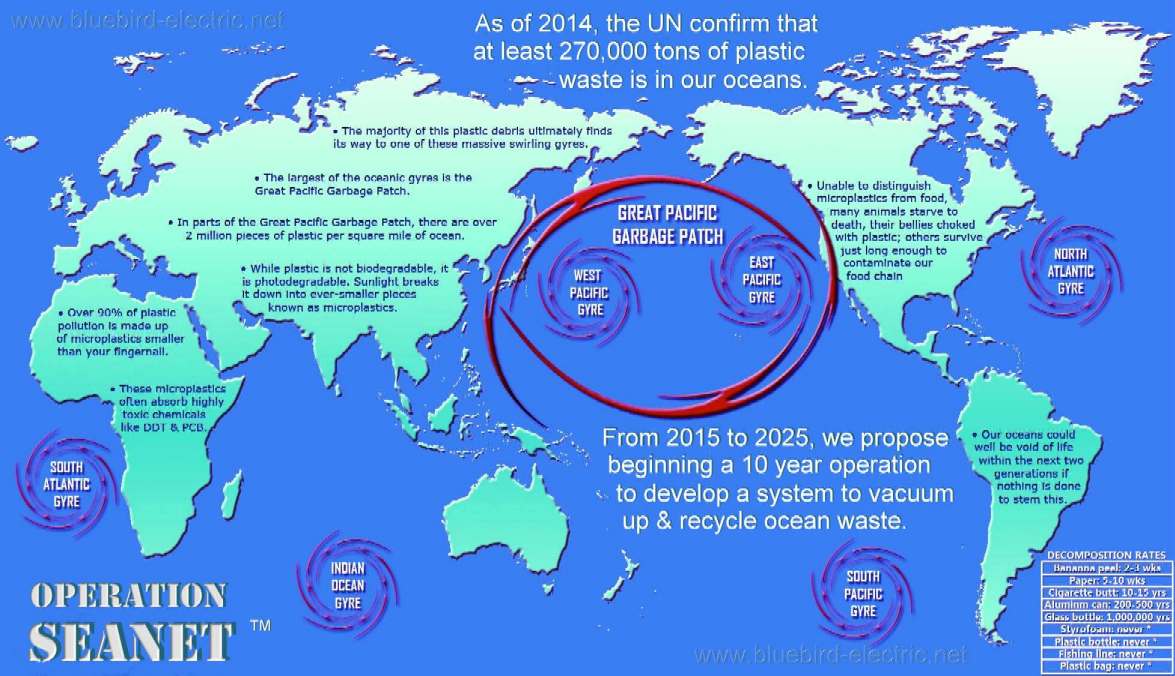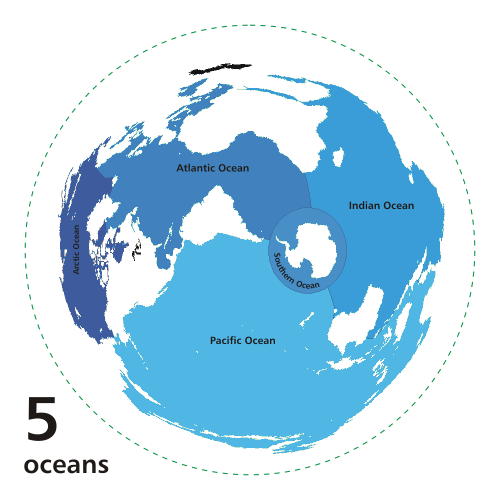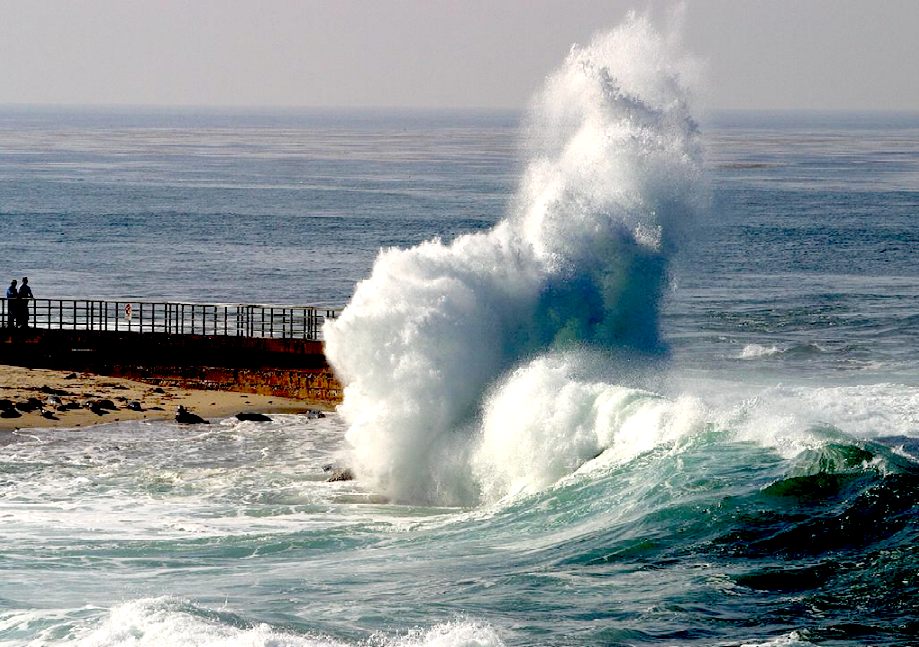|

Many people use the terms "ocean" and "sea" interchangeably when speaking about the ocean, but there is a difference between the two terms when speaking of geography (the study of the Earth's surface). Seas are smaller than oceans and are usually located where the land and ocean meet. Typically, seas are partially enclosed by land.
|
Ocean
or Sea
|
Total
Volume
|
Surface
Area
|
Ave
Depth
|
Max
Depth
|
Deepest
Trough
|
Latitude
|
Longitude
|
|
....
|
|
All
Oceans of the Earth
|
1,370,000,000 km³
|
361,000,000 km²
|
3,795 m
|
11,033 m
|
Mariana
Trench
|
11° 23' N
|
142° 37' E
|
|
Greater
Pacific Ocean
|
674,052,000 km³
|
164,015,000 km²
|
4,110 m
|
11,033 m
|
Mariana
Trench
|
11° 23' N
|
142° 37' E
|
|
Pacific
Ocean
|
663,871,000 km³
|
155,110,000 km²
|
4,280 m
|
11,033 m
|
Mariana
Trench
|
11° 23' N
|
142° 37' E
|
|
South
China Sea
|
3,831,000 km³
|
2,319,000 km²
|
1,652 m
|
5,016 m
|
South
China Sea Deep
|
|
|
|
Bering
Sea
|
3,300,000 km³
|
2,292,000 km²
|
1,440 m
|
4,773 m
|
Bering
Sea Deep
|
53° 00' N
|
177° 49' E
|
|
Sea
of Japan
|
1,361,000 km³
|
1,008,000 km²
|
1,350 m
|
3,742 m
|
Japan
Sea Deep
|
|
|
|
Sea
of Okhotsk
|
1,332,000 km³
|
1,590,000 km²
|
838 m
|
3,658 m
|
Okhotsk
Sea Deep
|
|
|
|
East
China Sea
|
235,000 km³
|
1,249,000 km²
|
188 m
|
2,782 m
|
East
China Sea Deep
|
25° 18' N
|
124° 52' E
|
|
Gulf
of California
|
111,000 km³
|
153,000 km²
|
724 m
|
3,600 m
|
Gulf
of California Deep
|
|
|
|
Yellow
Sea
|
11,000 km³
|
294,000 km²
|
37 m
|
152 m
|
Yellow
Sea Deep
|
|
|
|
Greater
Atlantic Ocean
|
315,514,000 km³
|
85,040,000 km²
|
3,710 m
|
8,605 m
|
Puerto
Rico Trench
|
19° 42' N
|
66° 14' W
|
|
Atlantic
Ocean
|
301,375,000 km³
|
76,762,000 km²
|
3,930 m
|
8,605 m
|
Puerto
Rico Trench
|
19° 42' N
|
66° 14' W
|
|
Caribbean
Sea
|
7,195,000 km³
|
2,718,000 km²
|
2,647 m
|
6,946 m
|
Caribbean
Sea Deep
|
|
|
|
Mediterranean
Sea
|
3,653,000 km³
|
2,509,000 km²
|
1,456 m
|
4,632 m
|
Mediterranean
Sea Deep
|
|
|
|
Gulf
of Mexico
|
2,367,000 km³
|
1,593,000 km²
|
1,486 m
|
3,787 m
|
Sigsbee
Deep
|
|
|
|
Black
Sea
|
547,000 km³
|
461,000 km²
|
1,187 m
|
2,212 m
|
Black
Sea Deep
|
|
|
|
North
Sea
|
54,000 km³
|
575,000 km²
|
94 m
|
660 m
|
North
Sea Deep
|
|
|
|
Baltic
Sea
|
23,000 km³
|
422,000 km²
|
55 m
|
421 m
|
Skagerrak
|
|
|
|
Greater
Indian Ocean
|
271,487,000 km³
|
69,792,000 km²
|
3,890 m
|
7,125 m
|
Java
Trench
|
10° 19' N
|
109° 58' E
|
|
Indian
Ocean
|
270,571,000 km³
|
68,326,000 km²
|
3,960 m
|
7,125 m
|
Java
Trench
|
10° 19' N
|
109° 58' E
|
|
Andaman
Sea
|
694,000 km³
|
798,000 km²
|
870 m
|
4,267 m
|
Andaman
Sea Deep
|
9° 50' N
|
93° 51' E
|
|
Red
Sea
|
215,000 km³
|
438,000 km²
|
491 m
|
2,266 m
|
Red
Sea Deep
|
23° 32' N
|
36° 54' E
|
|
Persian
Gulf
|
7,000 km³
|
230,000 km²
|
30 m
|
100 m
|
Persian
Gulf Deep
|
|
|
|
Greater
Southern Ocean
|
~90,000,000 km³
|
20,327,000 km²
|
~4,400 m
|
7,235 m
|
South
Sandwich Trench
|
60° 00' S
|
24° 45' W
|
|
Southern
Ocean
|
~90,000,000 km³
|
20,327,000 km²
|
~4,400 m
|
7,235 m
|
South
Sandwich Trench
|
60° 00' S
|
24° 45' W
|
|
Greater
Arctic Ocean
|
17,095,000 km³
|
15,288,000 km²
|
1,118 m
|
5,450 m
|
Eurasia
Basin
|
82° 22' N
|
19° 33' E
|
|
Arctic
Ocean
|
16,937,000 km³
|
14,056,000 km²
|
1,205 m
|
5,450 m
|
Eurasia
Basin
|
82° 22' N
|
19° 33' E
|
|
Hudson
Bay
|
158,000 km³
|
1,232,000 km²
|
128 m
|
183 m
|
Hudson
Bay Deep
|
|
|

OPERATION
SEANET -
Was an
ambitious 10 year plan to alleviate plastic ocean waste. The speed that
such an operation might swing into action, depends entirely on the
generosity of organisation around the world who either manufacture, or
who use plastic for packaging. The actual figure for plastic in our
oceans at 2015, was nearer 8 million tons, but could be as high as 12
million tons. Unfortunately, with the lust for single use plastic that
humans can now not do without, the world is waiting with bated breath
for a miracle cure. There is no such thing, but the next best thing
could have been Operation
Seanet. It proved to be impossible to obtain funding, through into
2022, after which the dream team disbanded to avoid insolvency. In 2024,
plastic is still being dumped in the oceans in increasing amounts.

MISS
OCEAN 2015 - SITTING
ON TOP OF THE WORLD - The lovely, Monika, sits atop a wooden post
with the summer sea breeze wafting gently in a south-easterly direction
as the tide in the English Channel laps onto a coarse pebble beach, near
the famous Eastbourne Pier. Monika would like to see a time when plastic
ocean waste is a thing of the past. Looking more like a mermaid in her
SeaVax 'T' shirt, than a dental techie, Monika very kindly gave her time
freely in order to promote the concept of cleaning up our oceans of
toxic plastic waste, for which all of us at the Cleaner Ocean Club are
extremely grateful.*

WHAT
IS AN OCEAN?
An ocean (from Ancient Greek Ὠκεανός, transc. Okeanós, the sea of classical antiquity) is a body of saline water that composes much of a planet's hydrosphere. On Earth, an ocean is one of the major conventional divisions of the World Ocean, which covers almost 71% of its surface. These are, in descending order by area, the Pacific, Atlantic, Indian, Southern, and Arctic Oceans. The word sea is often used interchangeably with "ocean" in American English but, strictly speaking, a sea is a body of saline water (generally a division of the world ocean) partly or fully enclosed by land.
Saline water covers approximately 72% of the planet's surface (~3.6×108 km2) and is customarily divided into several principal oceans and smaller seas, with the ocean covering approximately 71% of Earth's surface. The ocean contains 97% of Earth's water, and oceanographers have stated that only 5% of the World Ocean has been explored. The total volume is approximately 1.35 billion cubic kilometers (320 million cu mi) with an average depth of nearly 3,700 meters (12,100 ft).
As it is the principal component of Earth's hydrosphere, the world ocean is integral to all known life, forms part of the carbon cycle, and influences climate and weather patterns. It is the habitat of 230,000 known species, although much of the oceans depths remain unexplored, and over two million marine species are estimated to exist. The origin of Earth's oceans remains unknown; oceans are believed to have formed in the Hadean period and may have been the impetus for the emergence of life.
Extraterrestrial oceans may be composed of water or other elements and compounds. The only confirmed large stable bodies of extraterrestrial surface liquids are the lakes of Titan, although there is evidence for the existence of oceans elsewhere in the Solar System. Early in their geologic histories, Mars and Venus are theorized to have had large water oceans. The Mars ocean hypothesis suggests that nearly a third of the surface of Mars was once covered by water, and a runaway greenhouse effect may have boiled away the global ocean of Venus. Compounds such as salts and ammonia dissolved in water lower its freezing point, so that water might exist in large quantities in extraterrestrial environments as brine or convecting ice. Unconfirmed oceans are speculated beneath the surface of many dwarf planets and natural satellites; notably, the ocean of Europa is believed to have over twice the water volume of Earth. The Solar System's gas giant planets are also believed to possess liquid atmospheric layers of yet to be confirmed compositions. Oceans may also exist on
exo-planets and exo-moons, including surface oceans of liquid water within a circumstellar habitable zone. Ocean planets are a hypothetical type of planet with a surface completely covered with liquid.
WHAT
IS A SEA?
A sea is a large body of salt water that is surrounded in whole or in part by land. More broadly, the sea (with the definite article) is the interconnected system of the Earth's salty, oceanic waters—considered as one global ocean or as several principal oceanic divisions. The sea moderates the Earth's climate and has important roles in the water cycle, carbon cycle, and nitrogen cycle. Although the sea has been
traveled and explored since prehistory, the modern scientific study of the sea—oceanography—dates broadly to the British Challenger expedition of the 1870s. The sea is conventionally divided into up to five large oceanic sections—including the IHO's four named oceans (the Atlantic, Pacific, Indian, and Arctic) and the Southern Ocean; smaller, second-order sections, such as the Mediterranean, are known as seas.
Owing to the present state of continental drift, the Northern Hemisphere is now fairly equally divided between land and sea (a ratio of about 2:3) but the South is overwhelmingly oceanic (1:4.7). Salinity in the open ocean is generally in a narrow band around 3.5% by mass, although this can vary in more landlocked waters, near the mouths of large rivers, or at great depths. About 85% of the solids in the open sea are sodium chloride. Deep-sea currents are produced by differences in salinity and temperature. Surface currents are formed by the friction of waves produced by the wind and by tides, the changes in local sea level produced by the gravity of the Moon and Sun. The direction of all of these is governed by surface and submarine land masses and by the rotation of the Earth (the Coriolis effect).
Former changes in the sea levels have left continental shelves, shallow areas in the sea close to land. These nutrient-rich waters teem with life, which provide humans with substantial supplies of food—mainly fish, but also shellfish, mammals, and seaweed—which are both harvested in the wild and farmed. The most diverse areas surround great tropical coral reefs. Whaling in the deep sea was once common but whales' dwindling numbers prompted international conservation efforts and finally a moratorium on most commercial hunting. Oceanography has established that not all life is restricted to the sunlit surface waters: even under enormous depths and pressures, nutrients streaming from hydrothermal vents support their own unique ecosystem. Life may have started there and aquatic microbial mats are generally credited with the oxygenation of Earth's atmosphere; both plants and animals first evolved in the sea.
The sea is an essential aspect of human trade, travel, mineral extraction, and power generation. This has also made it essential to warfare and left major cities exposed to
earthquakes and
volcanoes from nearby faults; powerful tsunami waves; and hurricanes, typhoons, and cyclones produced in the tropics. This importance and duality has affected human culture, from early sea gods to the epic poetry of Homer to the changes induced by the Columbian Exchange, from Viking funerals to Basho's haikus to hyperrealist marine art, and inspiring music ranging from the shanties in The Complaynt of Scotland to Rimsky-Korsakov's "The Sea and Sinbad's Ship" to A-mei's "Listen to the Sea". It is the scene of leisure activities including swimming, diving, surfing, and sailing. However, population growth, industrialization, and intensive farming have all contributed to present-day marine pollution. Atmospheric carbon dioxide is being absorbed in increasing amounts, lowering its pH in a process known as ocean acidification. The shared nature of the sea has made
over-fishing an increasing problem.

INDIAN
OCEAN - Tsunami breaking waves over Thailand in 2004
WHAT
IS THE WORLD OCEAN?
The World Ocean, world ocean, or global ocean, is the interconnected system of Earth's oceanic (or marine) waters, and comprises the bulk of the hydrosphere, covering almost 70% of
Earth's surface, with a total volume of 1.332 billion cubic kilometers.
The unity and continuity of the World Ocean, with relatively free interchange among its parts, is of fundamental importance to oceanography. It is divided into a number of principal oceanic areas that are delimited by the continents and various oceanographic features: these divisions are the Atlantic Ocean, Arctic Ocean (sometimes considered a sea of the Atlantic), Indian Ocean, Pacific Ocean, and Southern Ocean (often reckoned instead as just the southern portions of the Atlantic, Indian, and Pacific Oceans). In turn, oceanic waters are interspersed by many smaller seas, gulfs, and bays.
A global ocean has existed in one form or another on Earth for eons, and the notion dates back to classical antiquity (in the form of Oceanus). The contemporary concept of the World Ocean was coined in the early 20th century by the Russian oceanographer Yuly Shokalsky to refer to what is basically a solitary, continuous ocean that covers and encircles most of Earth.
If viewed from the southern pole of Earth, the Atlantic, Indian, and Pacific Oceans can be seen as lobes extending northward from the Southern Ocean. Farther north, the Atlantic opens into the Arctic Ocean, which is connected to the Pacific by the Bering Strait, forming a continuous expanse of water.
The Pacific Ocean, the largest of the oceans, also reaches northward from the Southern Ocean to the Arctic Ocean. It spans the gap between Australia, Asia, the Americas and Oceania. The Pacific Ocean meets the Atlantic south of South America at Cape Horn.
The Atlantic Ocean, the second largest, extends from the Southern Ocean between South America, Africa, North America and Europe, to the Arctic Ocean. The Atlantic meets the Indian Ocean south of Africa at Cape
Agulhas.
The Indian Ocean extends northward from the Southern Ocean to India, between Africa and Australia. The Indian Ocean joins the Pacific Ocean to the east, near Australia.
The Arctic Ocean is the smallest of the five. It joins the Atlantic near Greenland and Iceland and joins the Pacific at the Bering Strait. It overlies the North Pole, touching North America in the Western hemisphere and Scandinavia and Siberia in the Eastern hemisphere. The Arctic Ocean is partially covered in sea ice, the extent of which varies according to the season.
The Southern Ocean is a proposed ocean surrounding Antarctica, dominated by the Antarctic Circumpolar Current, generally the ocean south of sixty degrees south latitude. The Southern Ocean is partially covered in sea ice, the extent of which varies according to the season. The Southern Ocean is the second smallest of the five named oceans.
The approximate shape of the World Ocean can for most purposes be treated as constant, although in fact it is not: continental drift continually changes its structure.

RELENTLESS
- The sea pounds against our shores continuously as a reminder that nature
is very potent, but humans are as exploitive as the oceans are powerful,
meaning that we should take care of nature - so that nature can take care
of us.
Solar
Cola drinkers care about planet
earth
..
Thirst for Life

(330ml
Planet Earth can)
|





